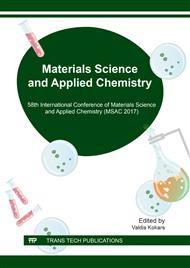[1]
T.R. Annunciado, T.H.D. Sydenstricker, S.C. Amico, Experimental investigation of various vegetable fibers as sorbent materials for oil spills, Marine Pollution Bulletin 50 (2005) 1340-1346.
DOI: 10.1016/j.marpolbul.2005.04.043
Google Scholar
[2]
M. Inagaki, A. Kawahara, J. Aizawa, H. Konno, Sorption and recovery of heavy oils using carbonized fir fibres and recycling, Desalination 40 (2002) 105-111.
DOI: 10.1016/s0008-6223(01)00083-5
Google Scholar
[3]
S. Jamaly, A. Giwa, S.W. Hasan, Recent improvements in oily wastewater treatment: Progress, challenges, and future opportunities, J. Env. Sci. 37 (2015) 15-30.
DOI: 10.1016/j.jes.2015.04.011
Google Scholar
[4]
E.E. Sirotkina, L. YU. Novoselova, Materials for Adsorption Purification of Water from Petroleum and Oil Products., Chem. Sust. Develop. 13 (2005) 359-375.
Google Scholar
[5]
A.A. Al-Majed, A.R. Adebayo, M.E. Hossain, A sustainable approach to controlling oil spills, J. Env. Manage. 113 (2012) 213-227.
DOI: 10.1016/j.jenvman.2012.07.034
Google Scholar
[6]
D. Dave and A.E. Ghaly, Remediation Technologies for Marine Oil Spills: A Critical Review and Comparative Analysis, Am. J. Env. Sci. 7 (5) (2011) 423-440.
DOI: 10.3844/ajessp.2011.423.440
Google Scholar
[7]
R. Asadpour, N.B. Sapari, Z.Z. Tuan, H. Jusoh, A. Riahi, O. Kalu Uka, Application of Sorbent materials in Oil Spill management: A review., Casp. J. Appl. Sci. Res. 2(2) (2013) 46-58.
Google Scholar
[8]
V. Rajakovic, G. Aleksic, M. Radetic, Lj. Rajakovic, Efficiency of oil removal from real wastewater with different sorbent materials, J. Hazard. Mater. 143 (2007) 494-499.
DOI: 10.1016/j.jhazmat.2006.09.060
Google Scholar
[9]
R. Frost, O. Carmody, Y. Xi, S. Kokot, Surface characterisation of selected sorbent materials for common hydrocarbon fuels, Surf. Sci. 601 (9) (2007) 2066-(2076).
DOI: 10.1016/j.susc.2007.03.004
Google Scholar
[10]
M. Inagaki, A. Kawahara, Y. Nishi, N. Iwashita, Heavy oil sorption and recovery by using carbon fiber felts, Carbon 40 (2002) 1487-1492.
DOI: 10.1016/s0008-6223(01)00319-0
Google Scholar
[11]
J. Xue, L. Zheng, H. Lu, B. Guo, Y. Wu, N. Qiao and B. Yan, Treatment of oil polluted marine environment through multi-functional materials, J. Chem. Pharm. Res. 6(5) (2014) 1504-1509.
Google Scholar
[12]
I.A.H. Al Zubaidy, U. Zaffar, N. Chowdhury, N. Mustafa, V. Varughese, R. Ahmed, R.A. Alharmoudi, A. Shahid, E.E. Gomes, Adsorption Study of Bio-Degradable Natural Sorbents for Remediation of Water from Crude Oil, 6th International Conference on Environmental Science and Technology, Volume 84 of IPCBEE (2015).
Google Scholar
[13]
M.M. Radetić, D.M. Jocić, P.M. Jovančić, Z. Lj. Petrović, H.F. Thomas, Recycled Wool-Based Nonwoven Material as a Oil Sorbent, Environ. Sci. Technol. 37 (5) (2003) 1008-1012.
DOI: 10.1021/es0201303
Google Scholar
[14]
O. Muter, K. Potapova, D. Porsnovs, M. Klavins, Biodegradation of Oil Sorbed on Peat after its Use as a Spill Cleanup Sorbent, Mat. Sci. Appl. Chem. 26 (2012) 120-126.
Google Scholar
[15]
S. Biswas, S.K. Chaudhari, S. Mukherji, Microbial uptake of diesel oil sorbed on soil and oil spill clean-up sorbents, J. Chem. Technol. Biotechnol. 80 (2005) 587-593.
DOI: 10.1002/jctb.1257
Google Scholar
[16]
S. Farag, N.A. Soliman, Biodegradation of Crude Petroleum Oil and Environmental Pollutants by Candida tropicalis Strain., Braz. Arch. Biol. Technol. 54 (4) (2011) 821-830.
DOI: 10.1590/s1516-89132011000400023
Google Scholar
[17]
D. Maliji, Z. Olama, H. Holail, Environmental studies on the microbial degradation of oil hydrocarbons and its application in Lebanese oil polluted coastal and marine ecosystem, Int.J. Curr. Microbiol. App. Sci 2(6) (2013) 1-18.
Google Scholar
[18]
O. Muter, K. Potapova, V. Nikolajeva, Z. Petriņa, T. Griba, A. Patmalnieks, R. Švinka, V. Švinka, Comparative study on bacteria colonization onto ceramic beads originated from two Devonian clay deposits in Latvia. Sci. J. RTU: Mater. Sci. Appl. Chem. 26 (2012).
Google Scholar
[19]
ASTM D1141-98(2013), Standard Practice for the Preparation of Substitute Ocean Water, ASTM International, West Conshohocken, PA, 2013, Information on www. astm. org.
Google Scholar
[20]
R. Feistel, S. Weinreben, H. Wolf, S. Seitz, P. Spitzer, B. Adel, G. Nausch, B. Schneider, D.G. Wright., Density and Absolute Salinity of the Baltic Sea 2006-2009., Ocean Sci. 6 (2010) 3-24.
DOI: 10.5194/os-6-3-2010
Google Scholar
[21]
J. Zhong, P. Wang, Y. Zhang, Y. Yan, S. Hu, J. Zhang, Adsorption mechanism of oil components on water-wet mineral surface: A molecular dynamics simulation study, Energy 59 (2013) 295-300.
DOI: 10.1016/j.energy.2013.07.016
Google Scholar


